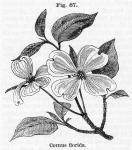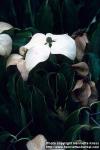
 Preparations: Extract of Cornus
- Fluid Extract of Cornus
Preparations: Extract of Cornus
- Fluid Extract of Cornus
The bark and bark of the root of Cornus florida, Linné
Nat. Ord.—Cornaceae.
COMMON NAMES: Dogwood, Flowering dogwood, Flowering cornel, Boxwood.
ILLUSTRATIONS: Bentley and Trimen, Med. Plants, 136; Johnson, Med. Bot. of N. A., Pl. 5.
Botanical Source.—Dogwood is a small, indigenous tree, from 12 to 30 feet high, with a very hard and compact wood, covered with a rough, brownish bark, much broken. It is a tree of tardy growth. The branches are opposite, spreading, smooth, and covered with a reddish bark, marked with rings at the place of the former leaves. The leaves are opposite, but partially expanded at the flowering time, ovate, acute, entire, petiolate, nearly smooth, dark-green and grooved above, and paler beneath, and marked with strong parallel veins. The flowers very small, of a greenish-yellow color, in beads or sessile umbels, upon peduncles an inch or more in length, surrounded by a large involucre, constituting the chief beauty of the tree when in flower. The involucre is composed of 4 white, nerved, obovate leaves, having their point turned abruptly down or up, so as to give them an obcordate appearance. The calyx is superior and campanulate, with 4 obtuse, spreading teeth. The corolla is composed of 4 oblong, obtuse, reflexed petals. Stamens 4, erect; anthers oblong, with filaments inserted in their middle. Style shorter than the stamens, erect, bearing an obtuse stigma. The fruit is an oval drupe of a glossy scarlet color, containing a nut, or nucleus, with 2 cells and 2 seeds (L.—W.).
History.—Cornus florida grows in various parts of the United States, but more abundantly in the middle states. It flowers in April and May, sometimes earlier and sometimes later than this, depending upon the climate. The fruit matures in autumn. This is one of the most conspicuous and handsome of our native trees when in bloom, and is frequently cultivated for its singular beauty. Its leaves turn red in the autumn. The wood is very compact and hard, and capable of receiving a high polish, and may be employed for many purposes. The American Indians extracted from the twigs and roots of this and other species a scarlet coloring matter for dyeing purposes. Dogwood bark was used considerably during the American Revolution as a substitute for Peruvian bark.
Description.—The bark of the stem, branches, and roots, is the medicinal part. That from the root is the best. It is found in commerce in broken fragments, somewhat quilled, 1/4 or 1/6 of an inch in thickness, ash-colored, with a reddish tinge, very friable, and very readily reduced to a powder of a similar color; it has but little odor, and its taste is astringent and feebly aromatic. Its properties are taken up by water or alcohol.
Chemical Composition.—Geiger, in 1836, obtained from the bark of the root a bitter principle (cornine), in pure form, and he proved that Carpenter's cornine is a mixture of calcium salts and the bitter cornine discovered by himself. Geiger's process is essentially as follows: Make a cold aqueous extract of the rootbark, shake with freshly prepared hydroxide of lead, filter, evaporate to dryness, abstract with absolute alcohol, filter again, add ether to turbidity, filter, and allow to evaporate spontaneously. Cornine crystallizes in silky needles, is soluble in water and alcohol, but sparingly soluble in ether. Its aqueous solution is precipitated by basic, but not by neutral, acetate of lead; also by silver nitrate. Tannic acid, mercuric, ferric, and barium chlorides are without effect upon it (Husemann and Hilger, 1884). Prof. Maisch, in 1859, showed that cornine is liable to be decomposed by exposure to heat or the atmosphere. The bark was found by H. K. Bowman (1869) and Chas. F. Kramer (1882) to contain 3 per cent of tannin (Amer. Jour. Pharm.).
Action, Medical Uses, and Dosage.—Dogwood bark is tonic, astringent, and slightly stimulant. It forms an excellent substitute for Peruvian bark, having frequently proved efficient in periodic attacks when the foreign drug failed. It may be used in many cases where quinine is indicated and can not be administered, owing to idiosyncrasy, etc. It may be used with advantage in cases where tonics are required, in periodical fevers, typhoid fevers, etc. Its internal employment increases the strength and frequency of the pulse, and elevates the temperature of the body. It should be used in the dried state, as the recent bark is apt to derange the stomach, and cause more or less pain in the abdomen, but which may be removed by 10 or 15 drops of laudanum. It is useful in headaches from quinine, in general exhaustion and pyrosis. An extract of the bark prepared by boiling it in water, and evaporating to the proper consistence, will be found one of the best forms in which to administer it. Dose of the powdered bark, from 20 to 60 grains, as often as required; of the extract, from 5 to 10 grains. The ripe berries formed into a tincture with brandy or whiskey, are a popular bitters among some country people; the flowers are occasionally used in the place of chamomile. Specific cornus, 1 to 20 drops.
Specific Indications and Uses.—"Tonic and antiperiodic; intermittent or miasmatic fevers; headache from quinine; general exhaustion" (Scudder); feeble, relaxed tissues; pulse feeble and temperature subnormal; quinism.
Related Species.—Cornus sericea, Linné. Swamp dogwood, Kinnikinnik, Rose-willow, Red-osier, Silky cornet, Red-willow. This is a shrub from 6 to 10 feet high. Stems several, erect, with a dark-red or purplish bark, and opposite, spreading branches, with downy twigs. Leaves opposite, from 2 to 4 inches long, half as wide, ovate, acuminate, varying from ovate and oval to lanceolate, nearly smooth above, with rather prominent veins, with a brown, silky down underneath, on petioles, from half an inch to an inch long. Flowers yellowish-white, small, disposed in large, terminal, depressed and woolly cymes or corymbs. Berries globose, bright-blue; stone compressed (L.—W.). Swamp dogwood is found in moist woods, and on the margins of rivers, from Canada to Carolina, flowering in June and July. The bark is the official part, that of the root being preferred. It resembles the bark of the following species (C. circinata) though it is not so warty and has a purplish tint. It possesses properties similar to those of Cornus florida, being, however, more astringent and less bitter. It has been found useful in dyspepsia and diarrhoea, and, in the same doses, may be employed as a substitute for the C. florida, and administered in a similar manner. An infusion is valuable in checking vomiting, especially that common to pregnancy and disease of the uterus. It has also been highly recommended in dropsy, ulcers, malignant fevers, and as an antiseptic.
Cornus circinata, L'Heritier. Round-leaved dogwood, Broad-leaved dogwood, Alder-leaved dogwood, Round-leaved cornel.—A shrub growing from 6 to 10 feet high, with straight, slender, greenish and verrucose branches. Leaves large, about as broad as long, orbicular, or very broadly oval, opposite, acuminate, waved on their edges, somewhat rough above, downy beneath. Flowers white, in small, spreading, depressed cymes, without an involucrum. Fruit, or berries, a bright-blue, becoming lighter colored as they ripen, small, soft, hollowed at base, and crowned with the persistent style (W.—G.). This plant is found in North America from Canada to the Carolinas, and west to Missouri, growing on river banks, copses, and elevated ridges, and flowering from May to August. The dried bark is usually greenish or grayish-white and warty when from young twigs, brown-gray from old branches, with shining-brown confluent verrucae, short, cylindrical, or semi-cylindrical pieces, having a slight odor, and a somewhat aromatic, astringent, and bitterish taste. It imparts its virtues to water, and, in chemical character, has thus far been found similar to Cornus florida (R. Gibson, 1880). An astringent tonic, which may be employed in all cases where such agents are indicated. An infusion of it may be made by infusing an ounce of the coarsely-powdered bark in a pint of boiling water, and may be given in doses of 1 or 2 fluid ounces, several times a day. It is useful in diarrhoea and dysentery, and also as a gargle in sore throat. One ounce of the bark affords 150 grains of an astringent, intensely bitter extract, which may be used with benefit. The medicinal virtues of the plant, as well as its doses, are similar to those of Cornus florida.
Specific Indications and Uses.—Bitter taste, aversion to food, continual nausea, indigestion. Tincture (℥viii to dilute alcohol Oj) 20 to 60 drops, 3 times a day.

